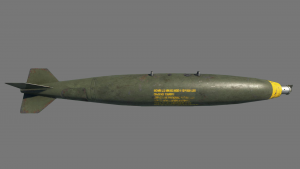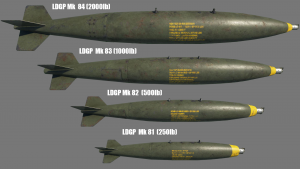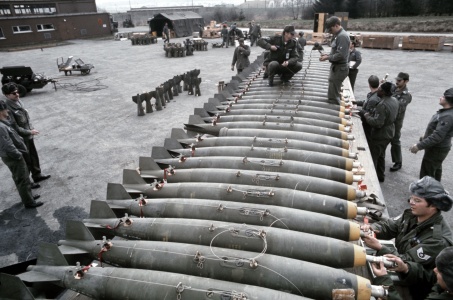500 lb LDGP Mk 82 bomb
Contents
Description
Write an introduction to the article in 2-3 small paragraphs. Briefly tell us about the history of the development and combat using the weaponry and also about its features. Compile a list of air, ground, or naval vehicles that feature this weapon system in the game.
Vehicles equipped with this weapon
| Vehicles equipped with Mk 82 AIR | |
|---|---|
| Jet fighters | |
| F-14 | F-14A Early · ▄F-14A IRIAF · F-14B |
| Strike aircraft | A-10C |
General info
| Bomb characteristics | ||
|---|---|---|
| LDGP Mk 82 / Mk 82 AIR | Mk 82 Snakeye | |
| Mass | 240.9 kg (531 lbs) | 254 kg (560 lbs) |
| Explosive mass | 87.1 kg | |
| Explosive type | Comp. H6 | |
| TNT equivalent | 117.59 kg | |
| HE max penetration | 82 mm | |
| Armour destruction radius | 7 m | |
| Fragment dispersion radius | 119 m | |
Effective damage
Describe the type of damage produced by this type of bomb (high explosive, splash damage, etc)
Comparison with analogues
Usage in battles
Describe situations when you would utilise this bomb in-game (vehicle, pillbox, base, etc)
Pros and cons
Summarise and briefly evaluate the weaponry in terms of its characteristics and combat effectiveness. Mark pros and cons as a list.
Pros:
Cons:
History
Early in aviation history, applications for aircraft to serve in a military capacity surfaced, not only with the intent to scout a battlefield from an aerial vantage point but for the possibility to drop explosive bombs too. Due to the frail nature of the early wood-frame and cloth covered aircraft, lifting capacity resulted in the ability to only carry small bombs. Effectively these early bombers were hailed as aerial artillery fire which could reach targets hundreds of miles further than the most powerful land-based cannons of the time. Prior to the war, contests abounded where pilots would drop oranges or flour sacks upon predesignated targets to see who could hit closes to the centre.
Italian aviators were the first to use bombs in a warfare capacity in 1912 during their campaign of Tripoli. These first bombs were conversions of existing cannon ammunition and were effective only against personnel as they did not provide a strong enough provision to damage hardened equipment or structures. As lifting capacity of aircraft increased, so did the ability for them to carry more and larger explosives.
For the United States, bomb design did not become a priority until the middle of 1917 when a French official came to the U.S. with several samples of the Gros Andreau bombs which the French were using in large quantities at that time. Immediately these bombs were accepted by the U.S. and used as a standard in developing the first three sizes to be implemented in the military. These three bombs were known as the early "Mark" series, 25 lb Mk.I demolition bomb, 50 lb Mk.I demolition bomb and the 100 lb Mk.I demolition bomb. By December 1917, only six months later, the military put forth requirements for the development of bombs larger than the existing 100 lb bomb. After two more months of development, production of demolition bombs up to 1,000 lbs was started. Rejected 3-inch artillery rounds were the basis for early 25 lb bombs which were modified into a streamlined shape, very similar to the British Cooper bombs of the time. Larger bombs were manufactured and filled with explosive filler, all of which were placed into a streamlined body, of which a cylindrical shape was the most advantageous.
Early on, the Mark series of bombs proved to be largely unsatisfactory in a number of different areas. The bomb body itself was weak due to the sheet metal it was made from and the number of welds needed to join the pieces together. The stabilizing fins were made of flimsy metal which tended to distort during both the handling and flight of the bomb, adversely affecting accuracy. For the field technicians, inserting the fuse was a complicated process which required removing the stabilizing fin structure potentially damaging the fins. The fuses tended to have a high fail rate and due to their design, they would instantly arm after release from the aircraft posing a direct to the delivery aircraft. Later modifications would eliminate many of the negative factors to include adding a nose fuse, time delaying arming of the fuse, strengthening of the stabilizing fins and adding primer detonators to ensure proper explosive train sequences. Other changes including streamlining all bomb bodies and utilising 100% T.N.T. as an explosive filler resulted in the newer "Modified Mark" series of Army bombs.
Prior to World War II, the military determined that the Modified Mark series of bombs were obsolete requiring newer and up-to-date bombs to be developed. Both the U.S. Army and Navy began development of their own series of bombs, the Army with the "M" series and the Navy with their "Mk" series. Both similar, these bombs were designed with parallel sides, an ogival nose and a boat tail which is a box type-tail reinforced to prevent warping and aid with accurate drops. Due to the shortage of T.N.T., the Army filled their bombs with 50/50 Amatol with T.N.T. ends to seal in the Amatol and protect it from moisture. The Navy, on the other hand, continued to manufacture their bombs with 100% T.N.T.
With the approach of World War II, the U.S. Army (including the Army Air Corps) and the Navy standardized their series of bombs allowing for interchanging between services, consolidating manufacturing capabilities and allowing for modifications which enabled British service aircraft to mount these bombs too. Even after the standardization of bombs in 1941, the standardization process went through a few phases of further refinement, the first of which changed all high-explosive bombs to be termed general purpose (G.P.) or general purpose high-explosive (G.P.H.E). Later the designation of demolition bomb would come back for a few specific bombs.
When bombs are dropped, there is always a chance that something in the explosive train of the bomb will fail and it will not explode. Early AN style bombs were defusable in the event they did not explode on contact, meaning that any unexploded AN bomb could have the fuses and boosters removed without the bomb exploding, rendering it inert. To counter this and allow for the potential "dud" bomb to explode when tampered with, the AN G.P.H.E. series bombs with the modification "A1" annotated that these bombs now had special pins mounted in the bomb's baseplate which fused with the explosive filler making it impossible to remove the booster without causing the bomb to detonate. Other modifications later added would include minor changes to the bomb body or the type of explosive filling used. During this time a second option for bomb tails was added, the box-type tail was already the mainstay of the bombs, however, to create a more aerodynamic bomb a conical tail assembly was added. This stretched out low profile tail improved the aerodynamics of the carrying aircraft, allowing it to carry more ordnance.
Progressing towards the Korean and Vietnam wars, piston-driven aircraft were giving way to jet fighters, bombers and attackers, many of which carried their ordnance on external pylons hung under the wing or underbelly. The new Mk 80 series bombs (Mk 81, 82, 83 and 84) were developed to keep external hung ordnance from creating too much drag on the delivery aircraft. Initially, the Mk 81 250 lb bombs were considered ineffective for their size or required a large amount to be effective and were removed from the munitions inventory. All-weather fighters and attackers were now being outfitted with the Mk series bombs and a new problem developed when it came to low-altitude attacks (typically coming in under low cloud cover) where the aircraft would deploy its ordnance which would hit the ground and explode catching the delivery aircraft in either the explosive blast or the shock-wave from the blast.
Modifications were developed to slow down or retard the flight of bombs, allowing for the delivery aircraft to depart out of the blast zone before they hit and detonated. Several options became available which allowed these bombs to remain aerodynamic low-drag while en-route to the target, but when deployed converted to high-drag, slower falling bombs. One option was to attach four bladed plates to the rear of the bomb so that when the bomb deployed, these plates would pop out and create high-drag to slow the fall. Another option was to use a ballute which was basically an airbag which deployed from the rear of the bomb that acted like a drogue chute, effectively causing high-drag. Later during the fighting in Iraq, the US military brought back the 250 lb Mk 81 bombs due to their ability to be used when deploying against a specific target and to help minimize collateral damage.
Media
- Images
See also
External links
Paste links to sources and external resources, such as:
- topic on the official game forum;
- other literature.
| Retarded bombs | |
|---|---|
| USA | |
| 250 lb | Mk 81 Snakeye |
| 500 lb | Mk 82 AIR · Mk 82 Snakeye |
| 1,000 lb | Mk 83 AIR |
| USSR | |
| 250 kg | OFAB-250Sh |
| 500 kg | FAB-500Sh |
| China | |
| 250 kg | 250-4 |
| 500 kg | 500-4 |
| Italy | |
| 230 kg | BFA-230/2 |
| 460 kg | BFA-460/2 |
| France | |
| 500 lb | SAMP Mk 82 250 Snakeye |
| 400 kg | SAMP Type 25 200 |
| 970 kg | SAMP Type 21 200 |
| Sweden | |
| 120 kg | M/71 retarded |
| See also | List of unguided bombs · List of armour-piercing bombs · List of guided bombs |






